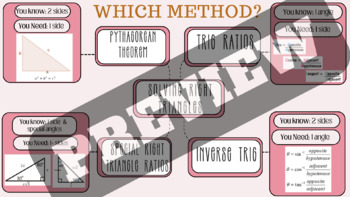Right Triangle Methods Visual
TheShapeShop
2 Followers
Grade Levels
7th - 10th
Subjects
Standards
CCSS7.G.A.1
CCSS8.G.B.7
CCSSHSG-SRT.C.8
CCSSMP1
CCSSMP5
Formats Included
- Portable Network Graphics
Pages
1 page
TheShapeShop
2 Followers
Description
This visual lists breaks down how to choose an appropriate method for solving for sides and angles in a right triangle. Methods on this visual include Pythagorean Theorem, Trig Ratios, Special Right Triangles Ratios and Inverse Trig Ratios. Guides students by having them identify what they know (given) and what they need to solve for.
This resource is best used at the end of a right triangle or trigonometry unit. Teaching how to choose an appropriate method for solving for parts of a right triangle is helpful before working on applied, real-world and word problems.
This visual can be used in any program you may use for lesson presentations. It can be printed and given to students as a handout, or laminated and hung in your classroom!
Total Pages
1 page
Answer Key
Does not apply
Teaching Duration
Other
Report this resource to TPT
Reported resources will be reviewed by our team. Report this resource to let us know if this resource violates TPT’s content guidelines.
Standards
to see state-specific standards (only available in the US).
CCSS7.G.A.1
Solve problems involving scale drawings of geometric figures, including computing actual lengths and areas from a scale drawing and reproducing a scale drawing at a different scale.
CCSS8.G.B.7
Apply the Pythagorean Theorem to determine unknown side lengths in right triangles in real-world and mathematical problems in two and three dimensions.
CCSSHSG-SRT.C.8
Use trigonometric ratios and the Pythagorean Theorem to solve right triangles in applied problems.
CCSSMP1
Make sense of problems and persevere in solving them. Mathematically proficient students start by explaining to themselves the meaning of a problem and looking for entry points to its solution. They analyze givens, constraints, relationships, and goals. They make conjectures about the form and meaning of the solution and plan a solution pathway rather than simply jumping into a solution attempt. They consider analogous problems, and try special cases and simpler forms of the original problem in order to gain insight into its solution. They monitor and evaluate their progress and change course if necessary. Older students might, depending on the context of the problem, transform algebraic expressions or change the viewing window on their graphing calculator to get the information they need. Mathematically proficient students can explain correspondences between equations, verbal descriptions, tables, and graphs or draw diagrams of important features and relationships, graph data, and search for regularity or trends. Younger students might rely on using concrete objects or pictures to help conceptualize and solve a problem. Mathematically proficient students check their answers to problems using a different method, and they continually ask themselves, "Does this make sense?" They can understand the approaches of others to solving complex problems and identify correspondences between different approaches.
CCSSMP5
Use appropriate tools strategically. Mathematically proficient students consider the available tools when solving a mathematical problem. These tools might include pencil and paper, concrete models, a ruler, a protractor, a calculator, a spreadsheet, a computer algebra system, a statistical package, or dynamic geometry software. Proficient students are sufficiently familiar with tools appropriate for their grade or course to make sound decisions about when each of these tools might be helpful, recognizing both the insight to be gained and their limitations. For example, mathematically proficient high school students analyze graphs of functions and solutions generated using a graphing calculator. They detect possible errors by strategically using estimation and other mathematical knowledge. When making mathematical models, they know that technology can enable them to visualize the results of varying assumptions, explore consequences, and compare predictions with data. Mathematically proficient students at various grade levels are able to identify relevant external mathematical resources, such as digital content located on a website, and use them to pose or solve problems. They are able to use technological tools to explore and deepen their understanding of concepts.


